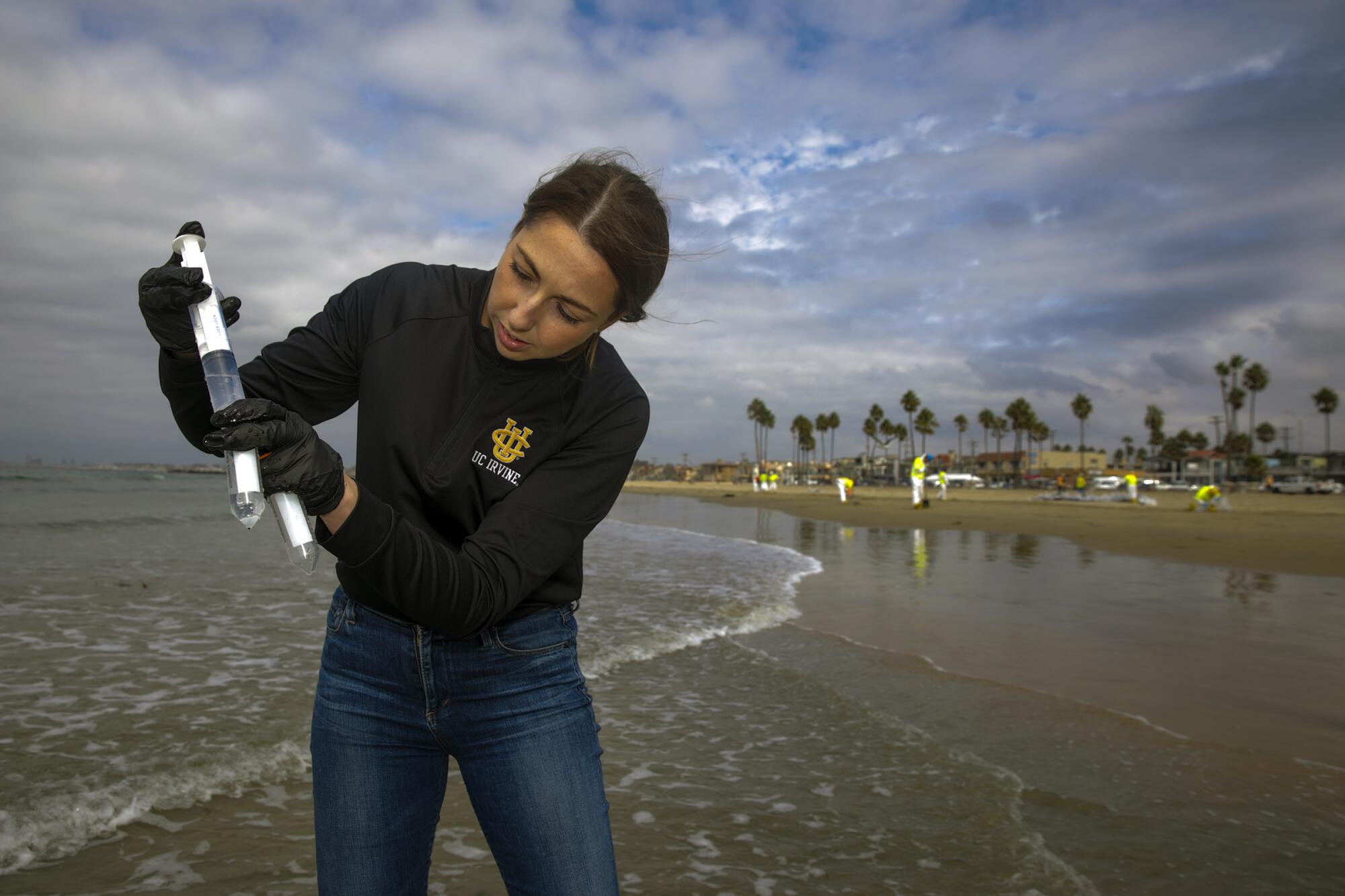
- Share via
Until now, the story of the worst local oil spill in decades has been told by gut-wrenching images oil-soaked birds, dying fish and fouled wetlands. However, these images reveal just part of the story, researchers say.
Although much of the public’s attention has focused on what may happen to future generations of whales, porpoises, seals, sea turtles and migratory birds, the emphasis of many researchers now has shifted toward the minuscule and mysterious ecosystem that scientists call the microbiome.
It is a vast menagerie of small and microscopic organisms that comprise the foundation of the food web in coastal marine ecosystems. It starts with zooplankton adrift in turgid currents and bacterial colonies in mudflats, rock crevices and canopies of kelp and meadows of eel grass undulating in the tidal surges. Then come single-celled animals that feed on the colonies, and the larger predators that in turn feed on them.

Now, in laboratories from the National Oceanic and Atmospheric Administration to UC Irvine, the big question is this: What were the impacts on viruses, bacteria, fungi, algae spores, zooplankton, fish eggs and fish larvae less than a quarter inch in length?
The labs’ findings are shedding new light on the potential long-term environmental damage from the spill and the ramifications of the nation’s fossil fuel addiction.
“When it comes to the lingering effects of oil slicks on marine organisms, size matters,” said John Incardona, a research toxicologist at NOAA’s Northwest Fisheries Science Center in Seattle. “Smaller organisms are going to get a bigger dose. Mature animals with gills and livers are generally less vulnerable to the toxic effects of oil.”
The scientific effort to understand how spilled oil affects Southern California’s coastal environment has suddenly become a hot topic of study at UC Irvine, where microbiologist Joleah Lamb and her students are collecting samples of seawater and kelp at nearby Newport Bay so that they can analyze and catalogue the types, sizes and compositions of contaminants they contain.

“Every ecosystem on Earth — from the human gut to oceans and wetlands — has been colonized by a microbiome that is important to its well-being and health,” Lamb said. “And that is where oil spills in the ocean have their biggest and potentially longest lasting impacts — the microbial worlds that produce half the oxygen we breathe and decompose organic matter.”
Ron Tjeerdema, a biologist at UC Davis and expert on biochemical mechanisms of toxicity in marine and freshwater systems, was only half joking when he said, “The scientific research community refers to these disasters as ‘oil spills of opportunity.’ That’s because getting a handle on the overall health of an ecosystem starts at the micro level.”
“Oil is literally a thousand or more chemical compounds ranging from unusually large asphalt components to small and highly toxic carbon molecules,” he said. “Microorganisms from viruses to bacteria have the capability to break down these compounds for their own protection, and even as a food source.”
“So, studying the microbial world is really important,” he added, “because it is an integral part of the natural recycling of elements and hydrocarbons that come out of oil.”

For fish, oil spills are linked to cardiac troubles and deformities in embryonic sacs. In studying the effects of the 2010 BP oil spill on bluefin tuna spawning in the Gulf of Mexico, a research team discovered that polycyclic aromatic hydrocarbons, or PAHs, block “signaling pathways” that allow potassium and calcium ions to flow in and out of cardiac cell membranes and sustain normal heart rates.
Even very low concentrations of crude oil can disrupt these signaling pathways, slowing the pace of heartbeats. Their study also suggests that PAH cardiotoxicity was potentially a common injury among a range of species in the vicinity of oil spilled into ocean ecosystems.

On Wednesday, Lamb and her team donned lab coats, pulled on rubber gloves and adjusted their safety goggles in preparation for experiments aimed at better understanding how climate change, heat waves, geography, ocean currents and now oil pollution are affecting Southern California’s already imperiled kelp forests, which camouflage complex ecosystems of fish, crabs, snails, urchins, bivalves, and anemones that blossom like colorful flowers.
One of the experiments is designed to test how oil affects the early life stages of kelp growing in carefully monitored aquariums. Another involves examining surface scrapings from adult kelp samples and identifying the chemical composition and DNA signatures of their microbial communities, which could signal potential imbalances in the marine environment’s ecological processes.

In the aftermath of oil spills, several features make kelp and kelp spores the size of a pinhead perfect for scientific study. They include kelp’s ability to absorb chemical elements and inorganic ions in seawater and concentrate them in its tissues.
Beyond that, creatures that feed on kelp include fish, which are eaten by sea lions. Another concern: Thick clumps of crude oil landing on kelp fronds and stems of eel grass could weigh them down, preventing them from absorbing enough sunlight to complete their life cycles.
It remains to be seen whether the spill will somehow undermine UCI’s long-awaited launch of a grant-funded kelp restoration effort.
“There are a lot of unknowns out there,” Lamb said.









